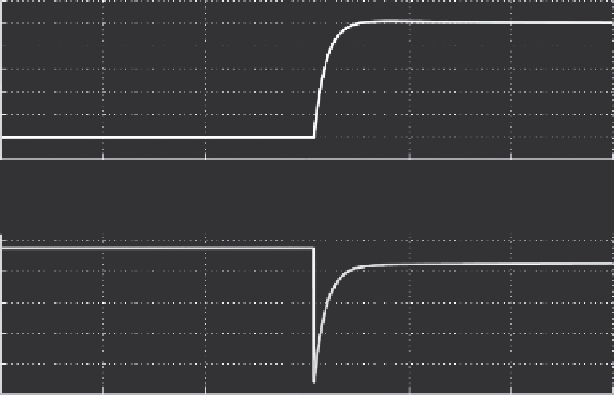Graphics Reference
In-Depth Information
5.5
RESULTS
5.5.1
s
imulation
e
nViRonment
The results of the first experiment are shown in Figures 5.13 and 5.14. Based on
Figure 5.13, the objective was to allow the controller to track a higher reference
level. The rendering process was allowed to stabilise at approximately 360 FPS
before triggering of a new reference level of 410. The PID controller took approxi-
mately 2,500 frames (6 s) to reach the target reference level. Furthermore, almost
no overshooting was observed. A small amount (fewer than 5 FPS) of tracking error
was noted. At a high frame rate of 400 FPS, this error can be regarded as negligible.
The PID control system was then tested for its ability to track a lower reference
level (380 FPS) from an initially higher frame rate (400 FPS). The results are shown
in Figure 5.14. Tracking was very accurate (error rate below 3 FPS) and no oscilla-
tion arose from the control action.
5.5.2 c
ontRol
s
ystem
with
a
ctual
R
endeRing
P
Rocess
The results of the second experiment in which the plant model is replaced by the
actual rendering process are presented in Figures 5.15 and 5.16.
In the first part of the second experiment, the rendering process was allowed to
stabilise at 350 FPS before a trigger changed the reference level to 390 FPS. The PID
control action took approximately 25,000 frames to reach a stable frame rate close
to the reference level. The steady-state error was approximately 5 FPS. In the second
part of the same experiment, the control system was allowed to track a 380 FPS
Simulated Input and Output of Rendering Process
420
410
400
390
380
370
360
35
1.22
1.225
1.23
1.235
Frame
1.24
1.245
1.25
×10
5
×10
4
-1.5
-2
-2.5
-3
-3.5
-
1.22
1.225
1.23
1.235
Frame
1.24
1.245
1.25
×10
5
FIGURE 5.13
Reference tracking using PID controller (low to high).

Search WWH ::

Custom Search